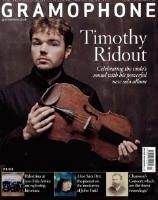Texte paru dans: / Appeared in: |
|||||||
 |
|
||||||
|
Bruckner’s unnumbered D minor symphony, composed three years after the First Symphony, might not be as frequently performed as its later companions but it enjoys extensive representation on record. Jordi Savall’s recording, however, is only the second one I’ve encountered that adopts historically informed performance practices for the work, following the approach used by Mario Venzago in his version for CPO.
As with Savall’s recordings of Beethoven’s Eighth and Ninth Symphonies, the orchestra features 39 strings, with a further 18 players bringing the total number of instruments to 57. The opening Allegro has a sharply etched quality, and when, after a minute or so, the second subject is presented by the strings, with the first violins divided into two sections, the texture has a chamber-music sonority. By contrast, the searching opening melody of the fourth movement, played by the firsts and seconds in unison, has as much warmth and expressiveness as any recording played using modern conventions.
Even more than Venzago, Savall conducts a fluid and impetuous interpretation of the score, pushing ahead in louder passages and slowing for softer ones. However, the result is considerably more compelling than Venzago’s version, featuring a fiery energy in climaxes and a strong feeling of poetry in the score’s quieter byways. The phrasing of solo clarinet, oboe and flute amid hushed strings from 6'47" in the first movement is exquisite, and the performance of the finale is a triumph, easily the finest of the two dozen recordings of the work I know of.
Schumann wrote both movements of the unfinished Symphony in G minor in Zwickau in 1832, eight years before starting work on the First Symphony, and revised the first for a performance in Leipzig the following year. Savall writes in the booklet note that this is a performance of the Zwickau version with some additions from the Leipzig revision. Unlike the recordings by Marriner and Schønwandt, which start with the first movement’s Allegro, Savall gives us the imposing introduction included in the recordings by Gardiner and Beermann, although with an additional timpani roll not heard in those versions. With a performance even finer than that of the Bruckner, Savall gives Schumann’s early symphonic writing a weight, thrust and emotional impact that’s enormously involving, making it seem hardly inferior to the four symphonies that would follow.
Both performances benefit from detailed and immersive recorded sound that’s also warm and well-balanced, and there’s a detailed booklet note in English, French, German, Italian, Spanish and Catalan. Altogether a recording not to be missed. |
|||||||
|
|||||||
|
|
|
||||||
|
Cliquez l'un ou l'autre
bouton pour découvrir bien d'autres critiques de CD |
|||||||
 Traduction".
Traduction".

/1744382447_small.jpg)


